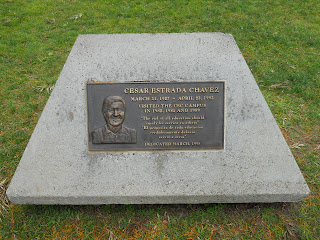 |
| Photo Credit: Monica C. |
A plaque that USC students had placed on campus in order to commemorate Cesar Chavez's multiple visits to campus and also to recognize his contribution to the Latino community in general.
Cesar Chavez visited the
University of Southern California in 1982, 1986, and 1989. His various visits
have been commemorated on a plaque in front of the Annenberg School of
Communication with Taper Hall of the Humanities to the north. On the plaque
there is a quote that states, “The end of all education should surely be
service to others”. The plaque was dedicated in March 1998. Chavez has also
been commemorated in a mural located in the conference room of El Centro
Chicano at the University of Southern California. The mural depicts the
evolution of the migrant farm worker into a college educated individual. Cesar
Chavez looks out over the scene with approval and happiness in his eyes.
Cesar Chavez was one of two
founders of the United Farm Workers union. He was born in Yuma, Arizona on
March 31, 1927. Cesar lived a very difficult life as a farm worker having lived
through terrible and unsafe working conditions as well as receiving very low
wages. As a child, Cesar was not able to excel in school because of his
inability to speak English. Cesar believed that his lack of education prevented
him from leaving his poor conditions behind. Thus, education became an
important issue to Chavez. This passion for education resulted in multiple visits
to various prestigious college campuses, including the University of Southern
California. As one of the most influential men throughout the Chicano movement
of the 1960s and 70s, it is important that he chose to visit institutions of
higher learning. Chavez was able to inspire college students decades after the
zenith of the Chicano movement.
This is not to say that the
plaque easily won its place on campus. The university was in a battle with the
Latino students on campus. La Raza Political Action Committee was formed in
1993 after the death of Cesar Chavez. This group of students wanted to rename
the park in front of Annenberg after the deceased political activist. They
argued that while the university had taken steps to increase the Latino student
population on campus, there was a severe lack of Latino representation within
the faculty. While the students were unsuccessful, they were able to
commemorate Chavez by dedicating a plaque in his honor.
The current Latino population at
USC is 13.9% which is a rather low percentage given the number of Latinos
living in California. The University does not provide access to statistics
about the ethnic makeup of faculty on campus. While Latinos remain a minority
on campus, the presence of the Cesar Chavez memorial plaque and the mural in El
Centro Chicano serve as a reminder of the struggle for equality for all current
and future Trojans.
Submitted by: Ale C., Monica C., Fabian S.
Submitted by: Ale C., Monica C., Fabian S.
Sources:
“History. ” El Centro Chicano. Web. 22 Apr. 2012.
< http://sait.usc.edu/elcentro/about/history.aspx>.
“The Story of Cesar Chavez: The Beginning.” United Farm Workers History. Web. 22
Apr. 2012. <http://www.ufw.org/_page.php?menu=research&inc=history/07.html>.
Doherty, Jake. “USC: Students Want Park Renamed for Chavez.”
Los Angeles Times October 10, 1993. Web.
22 Apr. 2012. http://articles.latimes.com/1993-10-10/news/ci-44390_1_usc-student>.
“Facts and Figures.” University
of Southern California: About USC. Web. 22 Apr. 2012. http://about.usc.edu/facts/>.
No comments:
Post a Comment